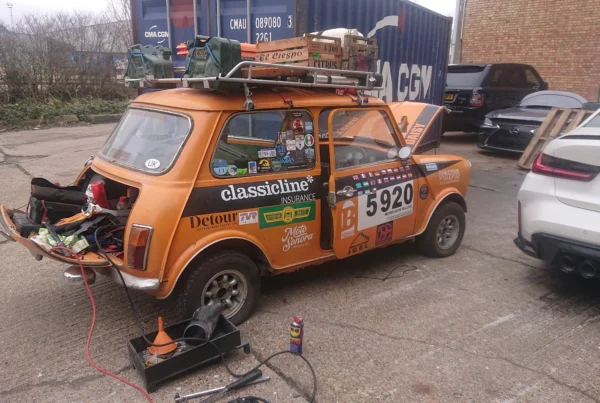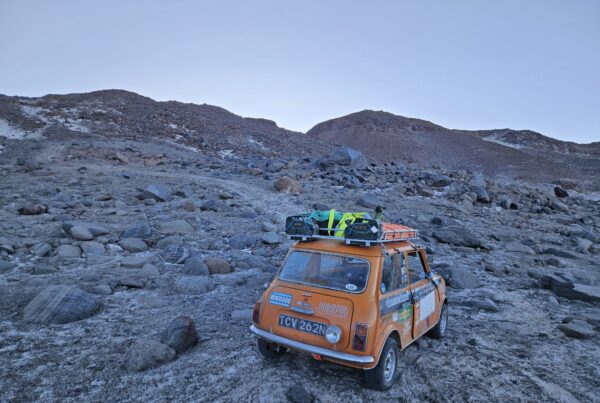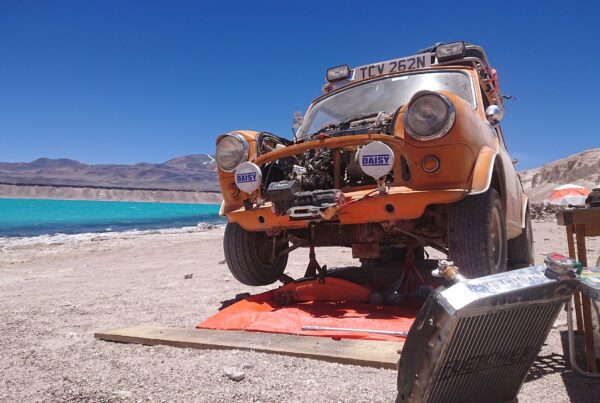Driving a classic Mini up the world’s highest volcano isn’t exactly a routine road trip. In the first of a series of articles, ClassicLine’s resident road tripper, Ben Coombs, explains some of the facts behind the ClassicLine Insurance sponsored Mini6000 Expedition…
We’re all familiar with what it takes to plan a road trip. Researching the most interesting stop-offs, hunting down the best driving roads between them, and fitting it all into a timeframe which works for you. But what if your road trip takes place on the side of a soaring volcano, 150 miles from the nearest settlement, in a couple of unreliable classics? Then, the planning becomes somewhat more serious. As if you get it wrong, it’s not only your enjoyment of the trip which could suffer – lives could be at risk.
This is the background against which we set about figuring out how we could drive a classic Mini and Range Rover up the world’s highest volcano.
The first consideration was the thin air of altitude.
While ostensibly we were setting out on a road trip, in reality the undertaking was as much a mountaineering expedition as a drive. Our goal was to take our Mini to an altitude higher than any mountain in Europe or North America; and altitude at which the risks are very real. Every year, people die from altitude-related ailments such as pulmonary or cerebral edema at much lower altitudes than we were aiming for, so we had to take this safety aspect seriously. We did this by following mountaineering best practise, meaning that once we were over 3,000 metres above sea level, our average gain in height was limited to an average of 250 metres per day, and it was this as much as any other consideration which determined the pace of our ascent, and the locations of our seven different camps up the mountain. Additionally, when possible we aimed to hike higher during the day, before returning to our lower sleeping altitude in the evening. This all helped our bodies to adapt to the gradually thinning air, while minimising the risk of altitude-related complications.
But in spite of this careful approach, things can still go awry, and with this in mind, we were very careful to keep an eye on our health. We checked our blood-oxygen levels multiple times a day, and listened carefully to our bodies, alert to headaches and illness, and only heading higher when everyone in the group felt fit and ready.
Another additional way in which we helped ourselves cope with the elevation was through food and hydration.
High altitudes cause significant dehydration, and so we were each aiming to drink five litres of water per day, alongside an increased food intake, to offset the extra calories we were burning on the mountain, 4-5,000 being the typical daily requirement.
Finally, we always made sure that if things went wrong, there was always an escape route.
The best cure for any altitude-related issue is to descend to thicker air, and so we always did our best to make sure this could happen as easily as possible. This wasn’t easy, given the car-related issues we faced on the mountain, but it was always in the back of our mind. And when our worries came true, and one of our party was exhibiting the symptoms of altitude sickness, the plan was able to swing quickly into place, and get them down to an altitude almost five kilometres lower within 24 hours.
But all this planning would matter little if we ran out of food and water in the desert. With the nearest shop or petrol station being 150 miles away, we had to be self sufficient in food, fuel and water at all times. This wasn’t easy; for instance our party needed over 20 litres of water per day, which soon adds up when you’re spending over three weeks in the wilderness. This requirement for supplies led to both cars being hugely overloaded when they headed into the wilderness. For instance, the Mini’s roof rack fractured as we passed the 4,000 metre level, due to being asked to carry over 100kg of fuel and supplies on rough dirt tracks. But even with these levels of supplies onboard, we couldn’t be completely self sufficient for over three weeks, and so supply runs were needed. Once a week on average, the Range Rover would undertake the 300 mile round trip to civilisation and back, returning with enough food and water for the coming week, plus enough fuel for the week’s adventures, and for us to get out of the wilderness and back into town if required.
As can be imagined, these logistical requirements required some extensive planning, as if we found we’d missed something we couldn’t exactly nip back to a shop and get it. Effectively, it wasn’t a road trip we were planning, but a wilderness expedition. And naturally, this meant we’d be spending almost a month living out in the wilderness, totally reliant on the contents of our cars, and their reliability.
So in the next update, we’ll look at that closer – what was life like on the mountain, what day-to-day challenges did we face, and how did we overcome them?






